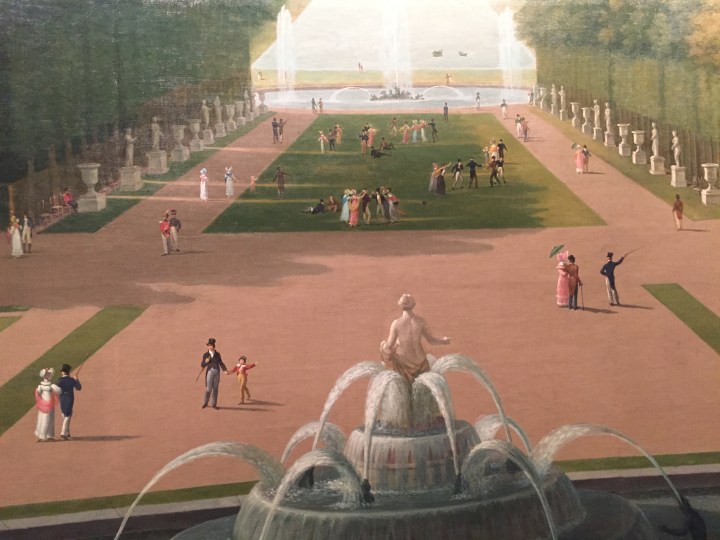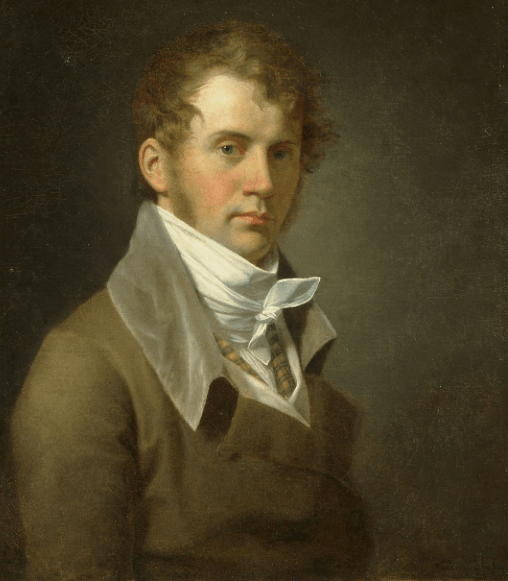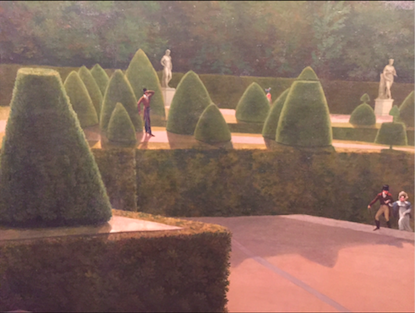
A few years ago, I was visiting The Metropolitan Museum of Art with my friend Catherine when we stumbled upon an unusual piece of art, purely by accident. It was tucked inside a small round room on the bottom floor of the American Wing and as I crossed the threshold, I knew we had discovered something special. It was a panorama, painted in the early 19th century. The walls that wrapped around us were covered with what appeared to be one long, floor-to-ceiling painting of the outside of the palace and gardens of Versailles. I hadn’t been to a panorama since I was a kid. I didn’t even know they made panoramas during the Regency era! Finding this room was like uncovering a historical secret.
According to the placard in the room, we were surrounded by Panoramic View of the Palace and Gardens of Versailles, which is an oil on canvas, painted by John Vanderlyn between 1818 and 1819. The description went on to say this painting was a rare survivor of a form of public art and entertainment that flourished in the nineteenth century: the panorama. Invented in Great Britain in the 1780s, panoramas (Greek for “all-sight”) were displayed within the darkened interior of a cylindrical building. Illuminated by concealed skylights, these circular paintings offered the illusion of an actual landscape surrounding the viewer. Like Vanderlyn’s Versailles, panorama subjects were usually foreign landmarks. Visitors paid a small admission fee and were rewarded with vicarious travel to different parts of the world. For those unable to travel, panoramas provided the perfect escape and crowds flocked to see them just as they do to movies today. In New York City, John Vanderlyn gave them that escape by helping them experience a stunning part of France.

Vanderlyn was a native of Kingston, New York and studded historical paintings in Paris during the Napoleonic era. He conceived his panorama project after seeing the American artist and inventor Robert Fulton establish a panorama theater on the Boulevard Montmartre. It was during 1814 and 1815 that Vanderlyn made his predatory studies at Versailles and then executed the huge painting (circumference 166 feet) in a barn in Kingston three years later. With the help of John Jacob Astor and other wealthy New Yorkers, he constructed a handsome Palladian building called The Rotunda behind New York City’s City Hall, where he exhibited his panorama and historical paintings. This building became New York’s first art museum.

Image of The Rotunda. Front piece to Views of the Public Buildings in the City of New York 1827. Courtesy of Wikimedia
As you entered Vanderlyn’s panorama of the Panoramic View of the Palace and Gardens of Versailles, you would appear to be standing at the head of the grand staircase on the parterre d’eau, or water park, with a view of the east of the massive western facade of the palace and the west of the vast gardens, great avenue, and grand canal. Vanderlyn cast the scene in the warm sunshine of a late summer afternoon (according to the panorama program it was between 4PM and 5PM, in September of 1814) and animated it was fashionably dressed visitors.
Both Catherine and I spent a good amount of time walking around the room, noticing all the charming details Vanderlyn included for the visitors of The Rotunda to admire. As an author, it was almost impossible for me not to make up stories in my head about a number of his scenes. Here are a few snippets of this masterpiece. As you take in the details of each image, ask yourself what you think might be going on with his cast of characters. There are stories everywhere.



I’ve saved my favorite vignette for last. I absolutely love this one. The man in the upper garden is searching for someone. Could it be the woman with the blue bonnet, walking along one of the pathways near the statues, or could it possibly be the woman with the blue shawl in the lower garden, on the arm of a neatly dressed gentleman? One of the fun parts about this piece is that you get to decide.

Note: The majority of information in this article was taken from the placards at The Metropolitan Museum of Art during the exhibition of this panorama.


Another fascinating post, Laurie!
LikeLike
Thanks a bunch, Melissa!
LikeLike
As a very young student, I visited the palace of Versailles in 1951. I have been addicted to the history of this era until now. I came across your site looking for dressing tables. What a wonderful find, it has made this sad year 2020, worthwhile. Thank you Lauren, I look forward to reading many more of your articles. Nanette (from Australia)
LikeLike
Hi Nanette, Thanks for visiting my blog. I’m glad you’ve enjoyed poking around at the different articles. I had fun learning about dressing tables and it’s nice to know how people find my blog. Take care and stay safe. LB
LikeLike